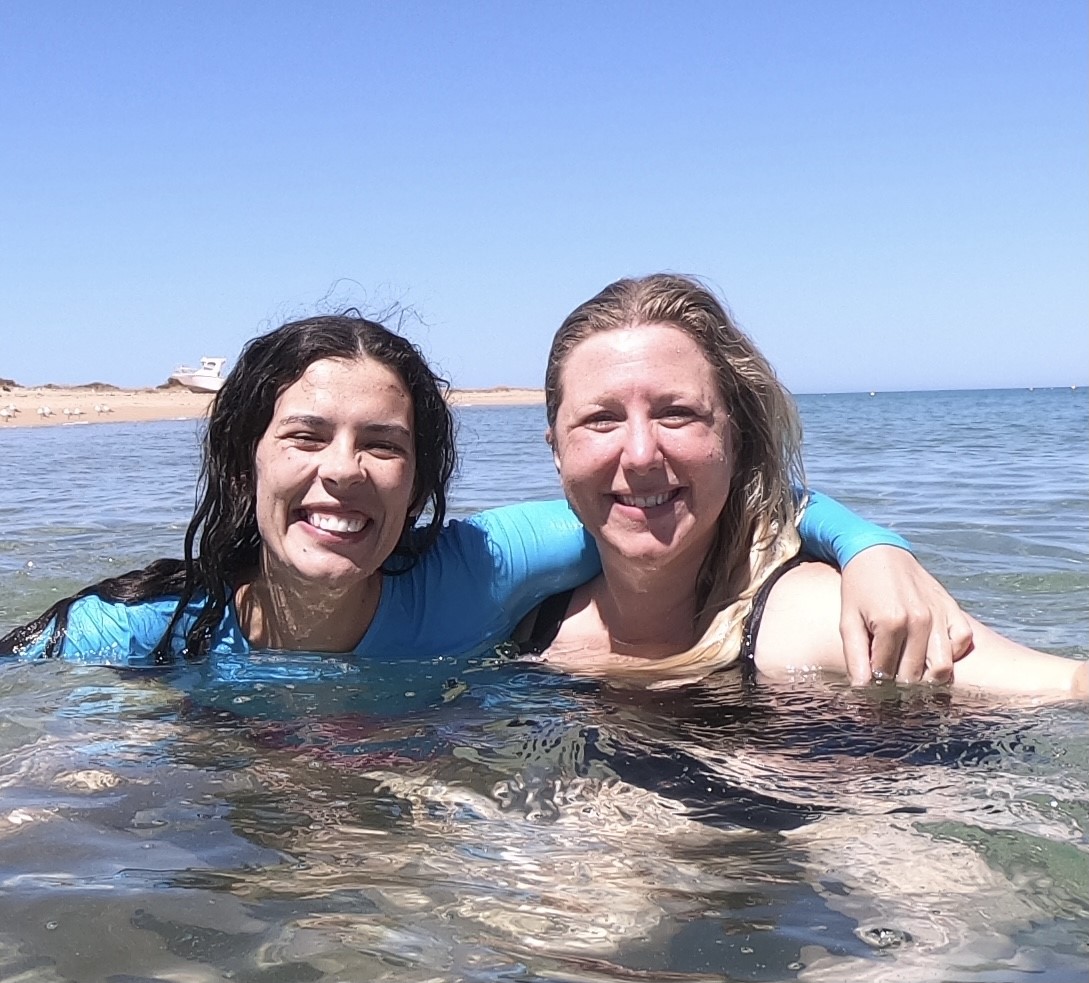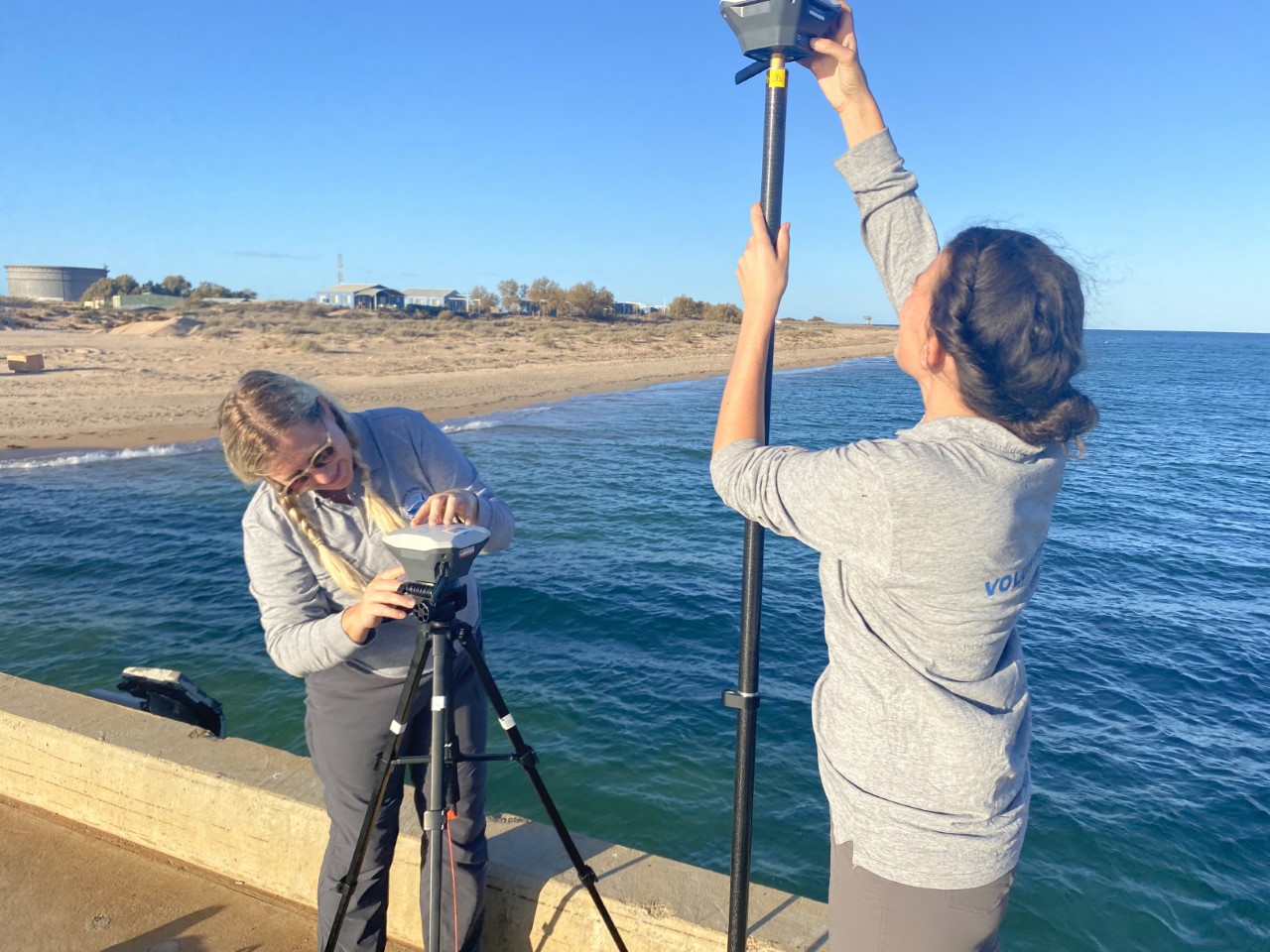Photo: Jenna (left) and Malindi (right) setting up the GPS system to relocate marked turtle nests to retrieve temperature loggers and assess nest success.
Jenna Hounslow (Murdoch University) and Malindi Gammon (University of Western Australia) are both working at the cutting edge of technology researching their PhD’s, and are currently in the Pilbara conducting fieldwork.
Malindi is researching the very first stage in a flatback’s life cycle – in the nest as an embryo!
Her study is investigating how climate change (and associated increase in storms, sand temperature and sea levels) will impact sandy beaches where flatbacks nest, as well as how successful those nests are.
She aims to develop a risk assessment of the effects of climate change on flatback nesting sites in the northwest of Western Australia.
The temperature of the sand affects whether embryos become male or female, or if too hot whether they even survive.
For eggs to hatch successfully they also need to be located above the high tide mark, meaning that rising sea levels could threaten whole nests.
Her risk assessment will inform conservation managers how likely negative events are and which sites may be most vulnerable.
Malindi relishes the fieldwork components of her PhD, working on the beach, it is not a bad office!
It is not all sand and sea though, a great deal of time goes into planning and preparing for fieldwork as well as reading published research, analysing data and communicating results.
She considers her most useful skills to be perseverance, creativity and problem solving.
To study the effects of sand temperature on a turtle’s nest Malindi must be on the beach at the perfect moment when a female turtle lays her eggs in the sand.
The eggs are delicately removed from the nest chamber then counted, sorted and marked to show where in the nest they came from.
A temperature logger array is inserted into the nest chamber and then the eggs are painstakingly replaced into the nest in as close to their original position as possible.
Malindi then recovers the nest with sand, trying her hardest to replicate the way that the mother turtle covers and camouflages her nest.
She has obviously spent time developing her technique, as when asked what her most memorable research experience was, she replied:
“Have you ever seen a sea turtle lay eggs? Once they have finished laying their eggs and covering them back over with sand, they do this little pitter-patter on top of the sand mound with their hind flippers. It’s my favourite thing.”
Malindi loved biology and outdoor education at school and if she could go back in time to give herself some advice at high school it would be:
“Whenever the opportunity presents, make sure you put your big boots on. I am borrowing from my friend Winnie the Pooh for this one: ‘When you see someone putting on their big boots, you can be pretty sure that an adventure is going to happen’.”
Malindi is hoping to continue a career in research after her PhD, following her interest in climate change and conservation.

Jenna’s research focusses on how an animal’s behaviour and physiology (body functions) interact to shape fitness, survival and success at the individual and population level.
Until recently it has been very difficult to study animals like sea turtles, who spend most of their time underwater, without disturbing them or biasing observations.
Most studies to date have been on lifecycle stages that occur on the beach at nesting time, but thanks to a partnership with Yawuru People in Broome (See Baby flatbacks found in Roebuck Bay article below) foraging areas for flatbacks were discovered, allowing Jenna an opportunity to catch turtles that are going about their daily lives.
Jenna’s research uses special tags that contain a high-definition camera to see life from the turtle’s point of view, but also measure body movements and activity in the same way we might use a fitbit or our smart phones to monitor activity.
The tags can measure every flipper beat for up to 1 week, as well as depth, water temperature, light intensity, body orientation, posture, speed and GPS locations.
The sensors record data 50 times per second and the result is massive data sets, so when Jenna is not leaning off the bow of a boat to net swimming turtles to tag, she is behind her desk working on developing artificial intelligence and machine learning algorithms to be able to make sense of all the data collected.
Jenna aims to try and answer questions like:
- How much time do flatbacks spend on activities like foraging and resting?
- What do flatbacks eat and what are the environmental and physiological drivers of foraging behaviour?
- How might foraging in flatback turtles be impacted by climate change, coastal development and recreational vessel use?
With a wide skill set in biology, mathematics, statistics, communication and planning she combines practical work on boats and organisational skills.
She too emphasises the need for problem solving skills in the field as things don’t always go to plan studying wildlife.
Describing her most memorable experience she said:
“It was very exciting when DBCA and Yawuru traditional owners discovered a foraging ground on Yawuru sea country at Roebuck Bay, near Broome. For the first time we had access to foraging flatbacks at sea! We caught a very special adult male flatback turtle who weighed over 80kg. He was the first flatback turtle I had ever met up close and was the first male flatback turtle ever to be caught for scientific research. We released the turtle where we caught him, with a camera tag attached to his carapace. For the first time ever, we got a turtle’s eye view of underwater life at Roebuck Bay.”
Since this time Jenna has gone on to discover and record a flatback turtle fending off a tiger shark – one of the predatory hazards they still face as fully-grown adults.
Jenna had an ambition to become a marine scientist from 11 years old, but also enjoyed art, so loves that her research allows her to combine science with her creative side.
The advice she would give to high school students wanting to study science further is:
“William Makepeace Thackery, and later President Abraham Lincoln said, ‘Whatever you are, be a good one’, I prefer a more realistic version of this – whatever you do, give your absolute best. This helps maintain a positive mindset, if you try your hardest at a wide variety of things you will find many paths and the right doors will open as a result.”
Jenna also hopes to continue a career in research, as she finds the thought of her research making a real difference to the conservation and survival of sea turtles very rewarding.

